


II. AllWISE Source Catalog and Reject Table
II.1. General Properties
The AllWISE Source Catalog contains accurate positions, motion measurements, photometry and ancillary information for 747,634,026 objects that were detected on the deep, coadded AllWISE Atlas Images.
Once detected, sources positions and fluxes were measured by fitting
PSF templates simultaneously to the "stack" of all Single-exposure images
in all WISE bands that cover their locations. Aperture flux measurements made on the coadded images are also provided for each source.
The AllWISE Reject Table contains 428,787,253
position, flux and motion measurements of the deep source
detections made on the Atlas images that but that
do not meet the criteria for
inclusion in Catalog. Reject Table sources may be duplicate, redundant extractions of real objects already in the AllWISE Source Catalog,
faint sources below the SNR limits for the Catalog, or
spurious detections of image artifacts or residual transient events.
The AllWISE Source Catalog is a significant improvement
over the
WISE All-Sky Release Catalog.
The WISE All-Sky Release Catalog may provide better photometry
than in the AllWISE Catalog for objects
brighter than the nominal W1 and W2 saturation limits
(W1<8 and W2<7 mag) that were observed during the
NEOWISE Post-Cryo survey phase. These saturated sources have systematically
larger photometric uncertainties in the AllWISE Catalog because
the measurement of saturated sources in the Post-Cryo images is
not as well characterized as it was in the 4-Band Cryo data.
This section provides a high-level description of the
format, information content and properties of the AllWISE Source Catalog.
More detailed discussions of the photometric and astrometric properties
of the Catalog are given in sections II.3
and II.5, respectively. The Catalog
completeness and reliability are described in
II.4.a and II.4.b,
respectively. The quality and interpretation of apparent motion measurements
are discussed in II.6 and in
Kirkpatrick et al. (2014).
The AllWISE Source Catalog is a highly reliable and complete
representation of compact sources of mid-infrared radiation over the
entire sky. But as with any very large Catalog, there known
features and issues of which you should be aware.
Please read the Cautionary Notes
to make the best use of the AllWISE Source Catalog in your
research.
II.1.b. Catalog Selection Criteria - The Difference Between the AllWISE Source Catalog and Reject Table
AllWISE data processing generates
a Working Database (WDB) of 1,176,421,279 deep
source extractions detected on the coadded Atlas Images. The full
AllWISE WDB contains extractions of real astrophysical objects,
as well as duplicate, redundant extractions of objects that fall within
the Tile overlap regions or are cases of
small-separation, same Tile (SSST) sources,
and spurious detections of image artifacts from bright sources,
faint noise excursions, and residual transient events not suppressed
during image coaddition.
The AllWISE Source Catalog is the subset of entries in the WDB that
are single, unique detections for each object, that lie farther than 50
arcsec from a Tile edge, and that satisfy the following
reliability criteria in at least one band:
- The profile-fit flux measurement must have SNR≥5,
- The entry should not be flagged as spurious detection of an image
artifact, and
- The measurement should have been extracted from a region covered
by five or more independent Single-exposure frames.
There are some special exceptions to these criteria to compensate
for the effect of W1 saturation during the
early part of the 3-Band Cryo survey. These exceptions and
all of the AllWISE Catalog source selection criteria are described
in detail in V.4.
747,634,026 WDB entries satisfy these criteria,
and constitute the AllWISE Source Catalog. The 428,787,253
WDB entries that do not meet these criteria are contained in the
AllWISE Reject Table.
II.1.c. Catalog Statistics
- Total number of entries in the AllWISE Source Catalog: 747,634,026
- Total number of entries in the AllWISE Reject Table: 428,787,253
- Band-detection Statistics for the AllWISE Source Catalog
The numbers of sources in the AllWISE Source Catalog with >2σ
detections in each of four WISE bands are listed in Table 1, along with the
same for the WISE All-Sky Release Catalog for comparison.
The band-detection combinations in the AllWISE Source Catalog are
given in Table 2. The AllWISE Source Catalog contains approximately 33% more detections in W1 and W2 than the All-Sky Release because of the increased
sensitivity resulting from the nearly factor of two deeper coverage
in those bands. The number of AllWISE Catalog W3 and W4 detections
is actually smaller than in the All-Sky Release Catalog because improvements to the local background estimation has reduced the number of faint "detections" in those bands that were usually associated with background structure.
The overwhelming majority of objects in the Catalog have detections in
the W1 band because that band has the best flux sensitivity and because
the spectral energy distributions of most objects on the sky favor
detection in that band. This is enhanced in AllWISE because
of the deeper coverage in W1 and W2 relative to W3 and W4. Because
AllWISE source detection and characterization is done on all bands
simultaneously, the preponderance of detections in W1 means that source
properties in this band, such as position reconstruction
and apparent motion, will weigh most heavily in the
measurements in all bands.
Although more than 99% of the AllWISE Catalog sources have W1 detections,
there are over 1 million objects that do not. These rare, red objects may
be among the most interesting detected by WISE.
Table 1 - Number of AllWISE and All-Sky Release Catalog Entries With >2σ Detections in Each Band
| | AllWISE Catalog | All-Sky Catalog |
|---|
| Band | Number of Objects | Percentage of Total | Number of Objects | Percentage of Total |
|---|
| W1 | 746,346,617 | 99.8 | 558,595,964 | 99.1 |
| W2 | 618,333,896 | 82.7 | 471,057,750 | 83.5 |
| W3 | 132,476,333 | 17.7 | 170,326,893 | 30.2 |
| W4 | 40,939,966 | 5.5 | 61,049,159 | 10.8 |
Table 2 - Band-Detection Combinations (>2σ per Band) in the AllWISE Catalog
| Band-Combination | det_bit | Number | Percentage of Total |
|---|
| W1-W2-W3-W4 | 15 | 25,882,083 | 3.5 |
| W2-W3-W4 | 14 | 35,528 | <0.1 |
| W1-W3-W4 | 13 | 859,426 | 0.1 |
| W3-W4 | 12 | 454,160 | 0.1 |
| W1-W2-W4 | 11 | 11,309,923 | 1.5 |
| W2-W4 | 10 | 15,556 | <0.1 |
| W1-W4 | 9 | 2,347,472 | 0.3 |
| W4 | 8 | 35,818 | <0.1 |
| W1-W2-W3 | 7 | 99,118,890 | 13.3 |
| W2-W3 | 6 | 71,392 | <0.1 |
| W1-W3 | 5 | 5,808,864 | 0.8 |
| W3 | 4 | 245,990 | <0.1 |
| W1-W2 | 3 | 481,471,559 | 64.4 |
| W2 | 2 | 428,965 | 0.1 |
| W1 | 1 | 119,544,951 | 16.0 |
| W1 (a) | 0 | 3,449 | <0.1 |
(a) - Sources with missing W1 profile-fit flux uncertainties because of
saturated
3-Band Cryo data that were "recovered" in the Catalog
selection process.
- Spatial Distribution of Catalog Sources
AllWISE Source Catalog sources are concentrated towards
the Galactic plane. Half of the Catalog entries are found within
approximately ±25° of the plane,
as can be seen in Table 3 which lists cumulative Catalog source counts
as a function of Galactic latitude. The flattening of the source
density profile at |b|>40°, as shown in
Figure 1, indicates the transition where extragalactic sources begin to dominate the Catalog counts. The dip in source density
right on the Galactic plane is caused by source confusion.
Table 3 - Catalog Cumulative Source Counts
| |b| < (deg) | Number | Percentage of Total |
| 2° | 26,021,652 | 3.5 |
| 5° | 50,560,983 | 6.8 |
| 10° | 164,981,320 | 22.1 |
| 20° | 307,315,043 | 41.1 |
| 30° | 425,394,932 | 56.9 |
| 40° | 523,161,615 | 70.0 |
| 50° | 602,911,102 | 80.6 |
| 60° | 666,080,299 | 89.1 |
| 70° | 711,387,282 | 95.2 |
| 80° | 738,560,212 | 98.8 |
| 80° | 747,634,026 | 100.0 |
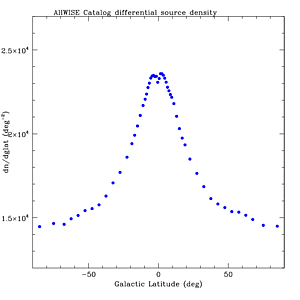 |
| Figure 1 - Differential AllWISE Catalog source density
plotted as a function of galactic latitude. |
The detailed distribution of Catalog sources on the sky is illustrated by
the source count maps in Figures 2-5. These Galactic
projection maps show the number of AllWISE Catalog sources in 0.2°x0.2° spatial bins
that have >2σ flux detections in each WISE band.
The concentration of sources towards the Galactic plane is clearly
visible, as are enhancements associated with the Large and Small
Magellanic Clouds and in W3 and W4 major star formation complexes.
The spoke-like features connecting the Ecliptic poles are caused by
enhanced coverage from the survey's moon
avoidance maneuvers. The decrease in source counts on the spoke
features near the Ecliptic plane is caused by Single-exposure images
that are rejected from the AllWISE Multiframe processing because of
scattered moonlight.
Comparing Figures 2-5 with the similar maps from the
WISE All-Sky Release Source Catalog (Figures 3-6 in section II.2.c of the All-Sky Release Explanatory Supplement)
reveals several important differences that highlight AllWISE improvements.
The gaps in the source counts caused by image smearing when
the spacecraft's magnetic torque rods were
activated are largely filled in W1 and W2 by the addition of the
second coverage epoch images. The sharp "halo" around the Galactic plane in W1 and W2 is smoothed out by the improved source detection and extraction algorithms. The large number of W3 and W4 "detections" that tracked the zodiacal dust bands and bright stars all around the sky in the All-Sky Release Catalog are greatly reduced in the AllWISE Catalog because of the improved background estimation algorithms.
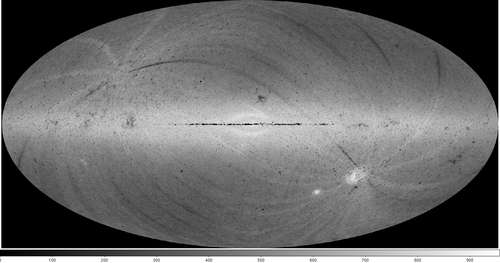 |
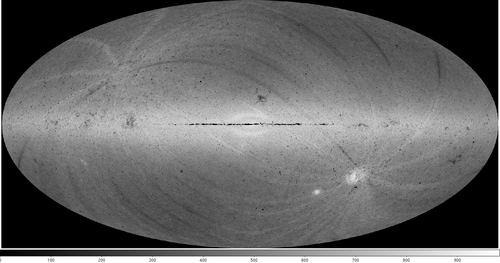 |
| Figure 2 - W1 |
Figure 3 - W2 |
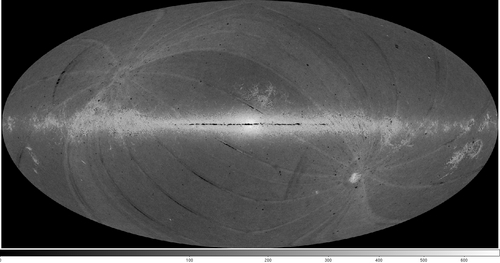 |
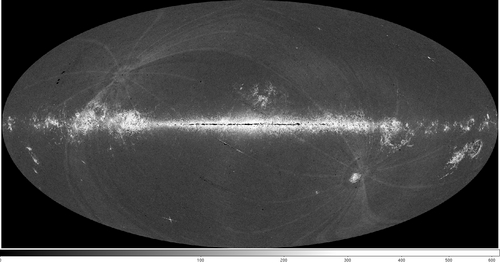 |
| Figure 4 - W3 |
Figure 5 - W4 |
| Hammer galactic projection grey-scale maps showing the
cumulative counts of >2-σ source detections computed in
0.2°x0.2° spatial bins, by band, in the AllWISE Source Catalog.
The W1 and W2 maps are linear stretches, with the intensity mapping
given by the scales at the bottom of the images. The W3 and W4
maps are log stretches. The Galactic center is at the center of the maps.
Galactic north is towards the top and
galactic longitude increases to the left.
The center of the maps corresponds to galactic coordinates
0°,0°. Galactic north is towards the top of the maps and
galactic longitude increases to the left. |
- AllWISE Source Counts and Catalog Depth
The completeness of the AllWISE Source Catalog is described
in section II.4.a. The AllWISE Catalog
is >95% complete for sources with W1<17.1 and W2<15.7 mag,
averaged over large areas of unconfused sky. This is 0.3-0.5 magnitudes
fainter than the All-Sky Release Catalog as expected from the factor of two
increase in depth-of-coverage in those bands. The W3 and W4 95% completeness
levels are W3<11.5 and W4<7.7 mag, unchanged from the All-Sky Release
because no additional data were included in those bands.
The AllWISE Source Catalog contains sources 1-2 magnitudes fainter than
the nominal completeness levels.
The specific completeness and depth of the Catalog vary around the sky,
depending on the survey depth-of-coverage, absolute background emission
level and structure, and local source density. Variations in the
AllWISE Catalog depth are illustrated in
Figure 6a-d, 7a-d and 8a-d that show a series of log source count histograms
and photometric uncertainties as a function of source brightness
for three representative regions. The source counts and
photometric uncertainty distributions from the WISE All-Sky Release
Catalog are shown in these plots for comparison.
Catalog source counts in a region on the ecliptic plane at
moderate galactic latitude that has ~24 frame coverage in W1 and W2,
and ~12 frame coverage in W3 and W4 are shown in Figures 6a-d.
In Figures 7a-d, the source counts and uncertainties are shown for a
region at high galactic
latitude, but deeper coverage, ~36 in W1 and W2 and 18 in W3 and W4.
Source counts for a very high source density region near the
Galactic center are shown in Figures 8a-d.
Some of the important features that can be seen in Figures 6-4 are:
-
AllWISE Catalog W1 and W2 source counts extend to fainter flux levels
than in the All-Sky Release Catalog because of increased depth-of-coverage
in those bands, except in the Galactic plane where confusion noise
limits the sensitivity. In the non-Galactic plane fields, the
improvement in sensitivity is approximately 0.4 mag as expected from
2x increase in coverage.
-
The W1 and W2 source counts extend to fainter magnitudes in
the the high galactic field than the lower latitude ecliptic plane
field because of the greater coverage depth in those bands.
- The W1 source counts cut off abruptly in the non-Galactic plane
fields near the magnitudes that correspond to SNR~5 (σ=0.2171 mag)
because of Catalog selection requirements.
The W2, W3 and W4 counts extend below SNR=5 because the fainter measurements
in those bands are usually accompanied by a SNR≥5 measurement in W1.
- AllWISE W1, W2 and W3 photometric uncertainties for sources brighter than
the nominal
saturation limits (W1<8, W2<7, W3<3.8 mag) are systematically
larger than in the All-Sky Release Catalog. Because of the increase
in the uncertainties, the brightest source flux measurements drop below SNR=5
and appear as 95% confidence upper limits in the AllWISE Catalog.
Hence, the All-Sky Release Catalog may have better photometric information
than the AllWISE Catalog for the brightest objects.
| |
Figures 6a-d |
Figures 7a-d |
Figures 8a-d |
| W1 |
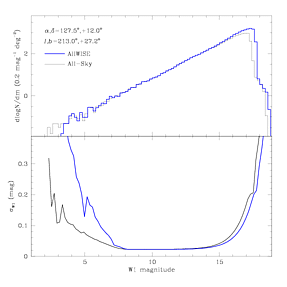 |
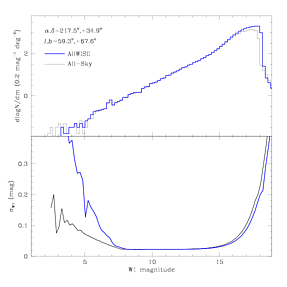 |
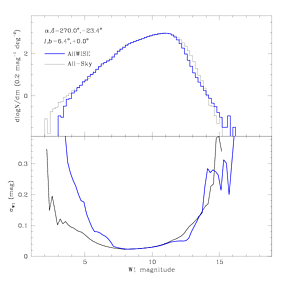 |
| W2 |
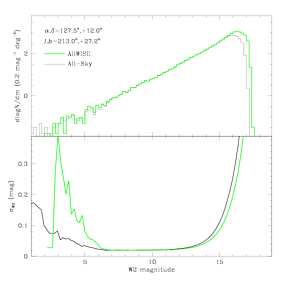 |
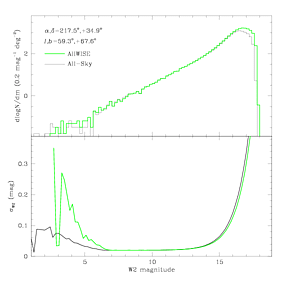 |
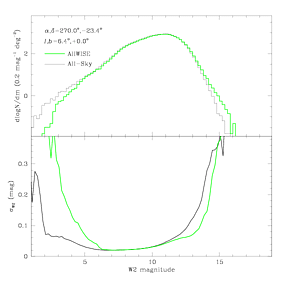 |
| W3 |
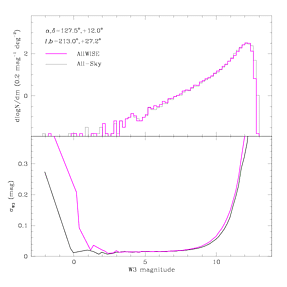 |
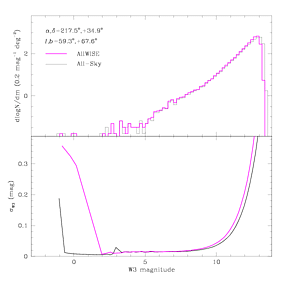 |
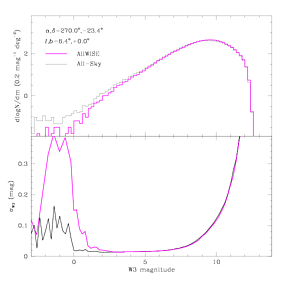 |
| W4 |
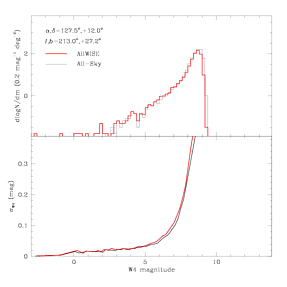 |
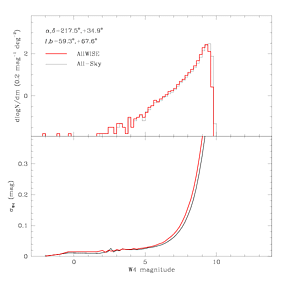 |
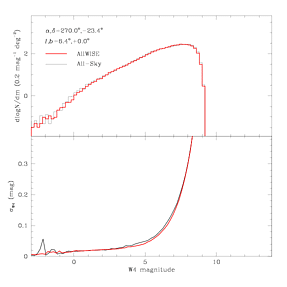 |
| |
α,δ=127.5°,+12.0°
l,b=213.0°,+27.2°
W1/W2 depth=24
W3/W4 depth=12 |
α,δ=217.5°,+34.9°
l,b=59.3°,+67.6°
W1/W2 depth=36
W3/W4 depth=18 |
α,δ=270.0°,-23.4°
l,b=6.4°,+0.0°
W1/W2 depth=24
W3/W4 depth=12 |
| Figures 6-8 - The diagrams above shows log source counts plotted as a function of
magnitude in the top panel, and the trimmed average profile-fit photometric
uncertainty in 0.2 mag wide bins plotted as a function of magnitude
in the bottom panel. AllWISE Catalog curves are shown in blue (W1), green (W2),
magenta (W3) and red (W4), and WISE Release All-Sky Catalog curves
are shown in black for comparison. The left column is for
a field on the ecliptic plan with the minimum, typical coverage.
The center column is a high galactic latitude plane with 50% more
depth-of-coverage. The right column is for a very high source density field
close to the Galactic center. |
II.1.d. Photometric Information
II.1.d.i Different Photometric Measurements in the Source Catalog
Several different sets of calibrated PSF profile-fit and aperture
source flux measurements in the four WISE bands are provided
for each deep detection in the AllWISE Source Catalog and Reject Table.
All include magnitudes and magnitude uncertainties, along with other
information specific to the type of photometry. A brief description of the
different photometry algorithms, their associated parameters,
and when each is appropriate are listed below.
Note that for all types
of photometry, if the flux measurement has SNR<2; the magnitude
quoted is derived from the 95% confidence flux upper limit, and the magnitude
uncertainty will be null. The one exception
to this is for the small number of sources severely affected by
W1 saturation in the early 3-Band Cryo
observations. These objects, identified in the Catalog by having a
photometric quality flag value in W1 of 'Z'
(ph_qual[1]='Z'),
usually have valid W1 Deep Detection profile-fit magnitude that is not
an upper limit, but have
w1sigmpro="null".
- Deep detection Profile-fit Photometry -
(w?mpro,
w?sigmpro,
w?snr,
w?flux,
w?sigflux)
These measurements are the PSF profile-fit measurements
that are made by chi-squared minimization
on the "stack" of all Single-exposure frames in all bands covering a
deep source detection. The instrumental flux measurements
and uncertainties, w?flux
and w?sigflux,
given in DN for the deep detection profile-fit measurements are always
the measured values, and w?flux is not a 95% confidence upper limit.
Most objects in the AllWISE Source Catalog are unresolved, so
the best photometric measurements to use are the deep detection profile-fit
photometry. These provide the highest SNR flux measurements
of faint sources, and objects that may be in close proximity
to other sources. Profile-fit photometry may underestimate the brightness of
extended sources.
- Averaged Single-exposure Profile-fit Photometry -
(w?magp,
w?sigp1,
w?sigp2,
w?nm,
w?m)
These magnitudes are computed from the inverse variance-weighted
profile-fit flux measurements made on the individual Single-exposure
images, forced at the position of the "stack" profile-fit source
extraction. The individual Single-exposure photometric measurements are
compiled in the Multiepoch Photometry Database,
and the averages and standard deviations of the population and
mean are carried in the AllWISE Catalog and Reject Table. The Single-exposure
profile-fit measurements are limited by the frame sensitivity, and do not
extend as faint magnitudes as the deep detection profile-fit measurements.
Note that the magnitude derived from the standard deviation of the
mean Single-exposure W1 fluxes, w1sigp2,
can be used as a proxy for w1sigmpro when the latter is missing
because of saturation in 3-Band Cryo images.
A number of other statistics derived from the distribution of
the Single-exposure measurements that are useful for detection and
classification of flux variability are also carried in the Catalog/Reject
Table entries, and are described in V.3.b.v.
- "Standard" Aperture Photometry -
(w?mag,
w?sigm,
w?flg,
w?mcor)
The standard aperture magnitudes are curve-of-growth corrected
magnitudes derived from flux measurements made on the coadded
Atlas Images. The fluxes are measured at the position of
the deep detection profile-fit extraction in 8.25" radius circular
apertures (W1, W2 and W3) and 16.5" in W4. The curve-of-growth correction,
given in the w?mcor,
is appropriate for unresolved objects, so these are not good
magnitudes for extended sources.
Aperture photometry is susceptible to contamination
from nearby objects and greatly underestimates the brightness of
saturated sources. The
w?flg values indicate
if the aperture measurements are contaminated in any bands.
- Multi-Aperture Photometry -
(w?mag_n,
w?sigm_n,
w?flg_n,
w?mcor_n where
n=1,2,3,4,5,6,7,8)
These magnitudes are derived from flux measurements made on the
coadded Atlas Images in a series of n=1,2,3,4,5,6,7,8
apertures with radii = 5.5", 8.25", 11.0", 13.75", 16.5", 19.25", 22.0",
24.75" (W1, W2, W3) and 11.0", 16.5", 22.0", 27.5", 33.0", 38.5", 44.0"
(W4). These magnitudes are not curve-of-growth corrected,
so are useful measurements for extended sources smaller than
the aperture sizes. However, aperture photometry is susceptible to
contamination from nearby objects and does not compensate for saturated or
missing pixels in the images. The
w?flg_n values indicate
if the raw aperture measurements are contaminated in any bands.
- Elliptical Aperture Photometry -
(w?gmag,
w?gerr,
w?gflg,
w?rsemi,
w?ba,
w?pa)
These magnitudes are derived from flux measurements made on
the the coadded Atlas Images for AllWISE deep extractions that
lie within 2 arcsec of the location of objects in the
2MASS Extended Source Catalog (XSC).
The measurements are made in elliptical apertures whose semi-major
axis, axial ratio and position angle are derived from those of
the associated 2MASS XSC source, and are given by the
w?rsemi,
w?ba, and
w?pa parameters.
The aperture semi-major axis is 1.1 times the 2MASS XSC
Ks isophotal circular semi-major axis.
AllWISE elliptical aperture photometry provides a better brightness
measure for galaxies that were previously identified by 2MASS.
Comparisons between AllWISE Catalog deep detection profile-fit
magnitudes and the average Single-exposure profile-fit and standard
aperture magnitudes are shown in Figures 9a-d.
The Deep Detection and
Single-exposure profile-fit measurements generally agree well
over the full brightness range well, with the exception of the
"glitch" that appears in the W1 and W2 deep detection photometry
in the range 6.5<W1<8 mag and 5.5<W2<7 mag.
The Deep Detection photometry briefly becomes ~10% brighter than
the Single-exposure profile-fit measurements in this range.
This discrepancy may be related to how the specific sections of
PSF wings changed during the Post-Cryo survey phase.
The Standard Aperture photometry increasingly underestimate the
flux of bright sources brightward of the nominal saturation levels in the
fours bands. Aperture measurements also become systematically
brighter than the profile-fit measurements towards fainter magnitudes
because of contamination of nearby sources within the measurement
apertures.
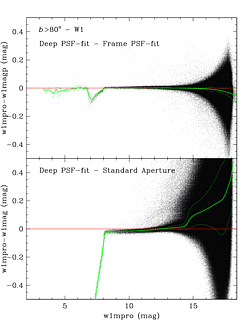 |
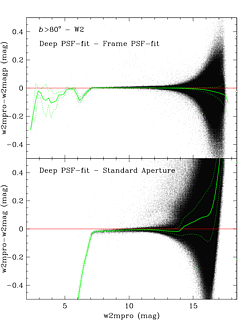 |
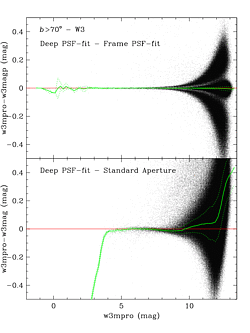 |
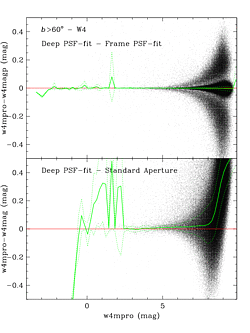 |
| Figure 9a - W1 |
Figure 9b - W2 |
Figure 9c - W3 |
Figure 9d - W4 |
| Differences between AllWISE Catalog Deep-detection profile-fit
magnitudes and Average Single-exposure profile-fit (top panels) and
Standard Aperture magnitudes (bottom panels), plotted as a function
of Deep-detection profile-fit magnitude for sources around the north
Galactic pole. Black dots are individual sources. The
solid green lines are the trimmed average differences in 0.2 mag
wide bins, and dashed green lines are the ±1 RMS difference
contours. |
II.1.d.ii Photometric Properties
Characterizations of the photometric sensitivity and accuracy of the AllWISE
Source Catalog are presented in II.3.a and
II.3.b.
In regions that are not confusion limited, AllWISE achieves
SNR=5 flux at 54, 71, 730 and 5000 mJy (16.9, 16.0, 11.5 and 8.0 mag)
in W1, W2, W3 and W4, respectively. The W1 and W2 sensitivity is
improved relative to that in the All-Sky Release Catalog. The W3 and
W4 sensitivity is also slightly improved relative to that in the
All-Sky Catalog because of the Single-exposure recalibration
and improved local background estimation algorithms used for
AllWISE data processing.
The differences between AllWISE Catalog and WISE All-Sky Release
Catalog profile-fit photometry for the same objects
are shown plotted as a function of AllWISE magnitude
in Figures 10a-d. These are the for sources in the same Ecliptic plane field
that is illustrated in Figures 6a-d.
AllWISE photometry is increasingly brighter than All-Sky Release
Catalog photometry for W1<14, W2<13, W3&;lt;8 and W4<6 mag.
because the
faint source flux underestimation bias that affected
the All-Sky Release Catalog photometry has been greatly reduced in AllWISE.
This improvement results from the
recalibration of the
Single-exposure image pixels done prior to AllWISE
Multiframe processing. AllWISE photometry of faint sources
is now much more consistent with that measured by Spitzer.
| W1 |
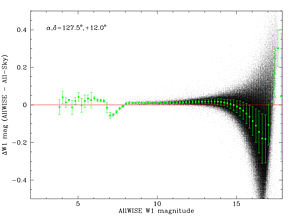 |
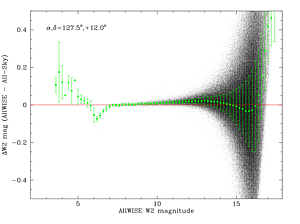 |
W2 |
| W3 |
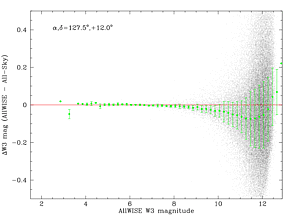 |
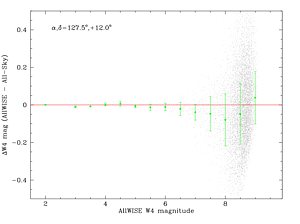 |
W4 |
| Figures 10a-d - The difference between
AllWISE Catalog and WISE All-Sky Release Catalog profile-fit
photometry as a function of AllWISE magnitude for the same ecliptic plane
field shown in Figures 6a-d. The small black dots are individual sources.
The larger green points and error bars are the trimmed average
and RMS photometric residuals in 0.2 magnitude wide bins (W1-W3) and
0.5 magnitude wide bins in W4. |
II.1.d.iii. Flux Variability
AllWISE Source Catalog and Reject Table entries that have a statistically
significant probability that their their Single-exposure
flux distributions varied over the course of the WISE observations are
identified by the var_flg.
Derivation of the var_flg is described in
V.3.b.vi.
Var_flg values ≥5 in any band indicate probable
flux variability.
In addition to the var_flg, each AllWISE source record includes
a number of statistics derived from the Single-exposure profile-fit flux
distributions that are useful when classifying variables sources.
These statistics are in the
w?k (Stetson K),
w?mlq (~100 × Stetson L),
w?ndf,
rho12,
rho23,
rho34,
q12,
q23, and
q34 columns.
Single-exposure profile-fit photometry light curves for every object
in the AllWISE deep detection Source Catalog and Reject Table are available
in the AllWISE Multiepoch Photometry Database.
II.1.e. Astrometric Information
II.1.e.i. Positions in the Source Catalog and Reject Table
J2000 equatorial source positions are provided
for each entry in the AllWISE Source Catalog and Reject Table.
Position reconstruction was done using bright 2MASS point sources as
the astrometric reference. For AllWISE, the proper motion of the reference
stars in the 11 years separating the WISE and 2MASS surveys
has been integrated into the solutions to improve the absolute astrometric
accuracy of the Catalog and Atlas (see V.2.b).
Two equatorial positions and associated uncertainties are provided
for each source. A brief description of the different positions is
given below, along with suggestions for their use.
- "Stationary" Positions -
(ra,
dec,
sigra,
sigdec,
sigradec)
These are the positions that are derived from the
deep detection profile-fit measurements
made without the small, linear motion term in the
source measurement model. This is the preferred position to
use for >99% of all Catalog sources because the great
majority do not have detectable apparent motion to AllWISE.
The galactic and
ecliptic coordinates listed for each Catalog
and Reject Table entry are derived from the stationary-fit
equatorial positions.
- "Motion-fit" Positions -
(ra_pm,
dec_pm,
sigra_pm,
sigdec_pm,
sigradec_pm)
The "motion-fit" positions are derived from the
deep detection profile-fit measurements
that incorporate small, linear motion term in the source measurement model.
These positions are computed for epoch MJD=55400.0 (UTC 2010.5589).
This is close to the midpoint of the WISE and NEOWISE survey
observations, so the "stationary" and "motion-fit" positions should
be very similar. The "motion-fit" positions are appropriate
for the few tens of thousands of AllWISE sources with detectable
motion.
II.1.e.ii. Astrometric Accuracy
The astrometric accuracy of the AllWISE Source Catalog is
described in II.5. AllWISE position
reconstruction is improved relative to that in the
All-Sky Release Catalog because proper motions of the 2MASS astrometric
reference stars has been taken into account, and the relative positions of
sources detected many times in overlapping Single-exposure images have been
used to rigidize the astrometric frame.
The positions of non-saturated, high SNR AllWISE Catalog
sources (8<W1<12 mag) in non-confused region are accurate to
~50 mas radially
with respect to those of the quasars that define the
ICRF.
AllWISE position accuracy gradually decreases with
decreasing source brightness.
II.1.e.iii. Apparent Motions
A major new feature of the AllWISE Source Catalog is the
measurement of apparent motion for nearly every deep detection.
The motion measurements are the result of having added small, linear
motion to the profile-fit source extraction
measurement model.
The motion-fit measurements and uncertainties are given in
pmra,
pmdec,
sigpmra,
sigpmdec.
Despite the "pm" prefix, the AllWISE motions do not distinguish between
proper motion and parallax. They are derived from total apparent
motion over the 6 or 12 months spanned by WISE and NEOWISE observations,
and can be influenced significantly by parallax for nearby objects.
Sensitivity to motion is a function of source brightness, the number
of independent Single-exposure observations covering and source,
and the total epoch spanned by the observations.
AllWISE motion measurements may be corrupted by source confusion,
contamination by image artifacts, extended emission and noise.
Detailed discussions of how to interpret AllWISE measurements,
the accuracy and limits of the motion measurements, and examples of true and
spurious motion measurements are given in II.6
and in
Kirkpatrick et al. (2014).
For non-saturated, high SNR point sources with two epochs of coverage,
AllWISE measures motions down to ~0.2 arcsec/year per coordinate axis, as
illustrated in Figure 11. Motion measurement uncertainties increase
with decreasing source brightness.
The motion of Barnard's star, the object with the largest known proper motion
(10.4 arcsec/year), is recovered with reasonable accuracy despite the fact
that it heavily saturated in the WISE images, and has significant parallax.
AllWISE can in principle detect larger motions, but no high confidence
detection of a non-Solar System object moving faster than Barnard's star
has been found yet.
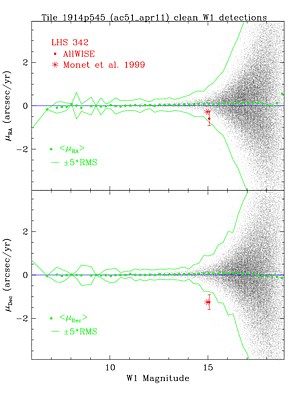
|
| Figure 11 - AllWISE Catalog RA (top) and Dec (bottom)
motions measured for sources in Atlas Tile 1914p545_ac51. Black points
are individual sources and green dots are the trimmed average motions
in 0.2 mag wide bins. The green lines show contours connecting
the 5*RMS value in each bin. Because most sources have zero motion
measurable by WISE, the green lines give a reasonable estimate of
the minimum measurable motion as a function of magnitude for this Tile.
The red point is the measured
motion of LHS 342, and the red star represents the actual motion
reported by Monet et al. (1992). |
II.1.f. Additional Information
II.1.f.1. 2MASS PSC and XSC Associations
Entries in the AllWISE Source Catalog and Reject Table
have been positionally cross-correlated with the 2MASS
Point and
Extended Source Catalogs (PSC and XSC).
A search radius of 3 arcsec was used for the
AllWISE/2MASS PSC correlation. If more than one 2MASS PSC object
was found within 3 arcsec,
the closest association was recorded. No correction was made for
proper motion between the epochs of 2MASS and WISE.
AllWISE Catalog and Reject Table source records include
the tmass_key, which is
the unique identifier of the associated 2MASS PSC source,
n_2mass, which is the number
of 2MASS PSC sources found within 3 arcsec of the WISE position,
the associated 2MASS source
J,
H and
Ks
photometry and uncertainties, and the amplitude and position angle of the
vector from the WISE source to the 2MASS source, in degrees East of North,
r_2mass and
pa_2mass.
282,835,124 (37.8%) AllWISE Catalog and
45,392,426 (10.6%) Reject Table entries have 2MASS PSC
associations within 3 arcsec.
Associations between AllWISE Catalog and Reject Table entries
and the 2MASS XSC were searched using a matching radius equal to
1.1 times the Ks isophotal radius size of
the 2MASS XSC source. This will identify WISE extractions that are both
identically the 2MASS XSC source, as well as some that are
fragments of or foreground objects superimposed on the extended object.
The separation between the AllWISE and 2MASS XSC positions is given
by xscprox.
Classification of AllWISE-2MASS XSC associates is given by
the ext_flg.
961,570 (0.13%) AllWISE Catalog and
156,231 (0.04%) Reject Table entries have 2MASS XSC
associations.
2MASS source information included in the AllWISE source records is an
association not an identification. Although the position accuracies of the
two Catalogs are excellent, there is a non-zero probability of chance
associations between physically unrelated objects, as well as missed
associations between the Catalogs. You should always confirm associations
by reviewing the entries from both Catalogs.
Last Updated: 24 October 2019































